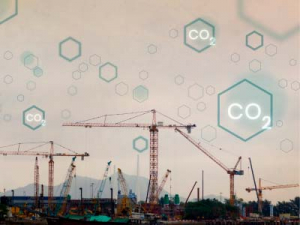The carbon footprint includes all greenhouse gas (GHG) emissions, whether direct or indirect, that result from an individual, company or country’s activities.
Since the industrial revolution, day-to-day human activity in all its diversity involves the consumption of fossil fuels to a greater or lesser degree. As a result, greenhouse gases (GHGs) are emitted into the atmosphere, leading to an increase in the total radiative forcing of the earth, increasing the temperature (global warming) and leading to climate change.
In other words, GHGs, whose concentration has increased significantly in recent decades, absorb part of the heat reaching the earth from the sun, which, in turn, increases the temperature of the planet.
The main greenhouse gases are carbon dioxide, methane, nitrogen oxide, water vapour and ozone, but it is CO2 that contributes the most to the increase in radiative forcing, and it also derives to a large extent from human activity.
The carbon footprint
The carbon footprint is the set of GHG emissions generated directly and indirectly by a person, a group, an organisation, a company, a region and even a product, a service, or an event. The tons of carbon equivalent (t CO2e) measure the carbon footprint because CO2 is the most abundant gas produced.
In other words, the carbon footprint is a fundamental environmental metric that provides information on the sources and sinks of GHG emissions. It serves as a management tool to identify the actions that contribute to the increase or decrease of the volume of GHG emissions of our activity related to our impact on climate change.
Today, the climate urgency has highlighted the need for a global transformation that begins with the individual, influences the business practices and produces changes at the governmental level. It is time to establish an economic model that values the needs of people and the environment, and that is sustainable over time and neutral in GHG emissions.
The carbon footprint and the individual
At the individual level, the carbon footprint would be the set of GHG emissions that a person generates in their daily activities, for example: by using energy in the form of electricity or heat, or by consuming fuels for transportation, or with the use of products or services, among other sources of emissions. Therefore, HC helps to identify those everyday actions that can reduce GHG emissions and fight climate change.
Hence, the importance of bringing the issue of global warming into the spotlight and launching awareness programmes, so people can make daily choices that are less harmful to the environment and society as a whole.
The carbon footprint of companies
When we turn our attention to the business sector, many companies have been reprimanded for the effects of their activity on climate change due to the large amounts of GHG emissions that they release into the atmosphere. Nowadays, companies of all sizes have the opportunity to lead the change towards a carbon-neutral society.
For these reasons, the carbon footprint is present in the sustainability strategies of many companies that want to manage the GHG sources and sinks, and their carbon footprint consequences for their business and stakeholders.
The calculation of an organisation’s carbon footprint involves the inventory of GHG sources and sinks derived from the activity carried out by that organisation. The quantity of the data will influence the complexity and scope of the study. Therefore, a company’s carbon footprint provides a numerical value of the total GHG emissions resulting from its activity.
This is only the first step in managing GHG emissions and moving towards neutrality. The second step would be to draw up an emission reduction strategy or plan (with actions aimed at reducing GHG emissions and a system for monitoring the reduction results). Finally, after implementing the reduction plan, remaining GHG emissions should be compensated through GHG reduction or removal projects outside the company.
Why do I need to know my company’s carbon footprint?
Understanding your company’s carbon footprint is important in order to know where to take action in your production chain to improve processes and reduce the environmental impact, particularly around carbon emissions.
You can also achieve savings by reducing the energy consumption of some of these processes, so calculating the carbon footprint os also a tool to reduce production and performance costs. It allows companies to make better decisions and achieve a more efficient management of energy consumption in all areas: mobility, lighting, heating, etc. Discover how to calculate carbon footprint.
Once you have calculated your company’s carbon footprint, you will need to offset the GHG emissions that cannot be abated by other means, by purchasing carbon credits and from sustainable development projects. These credits are expressed in tons of CO2, representing the equivalent GHG emissions, and can also be generated by carbon capture projects.
Offset carbon footprint with ClimateTrade
ClimateTrade’s marketplace offers more than 150 certified sustainable projects that meet the Sustainable Development Goals stipulated by the United Nations. Through our state-of-the-art technology, we ensure that the financing of these projects is transparent and traceable, guaranteeing, at the same time, direct and positive impacts on the environment and society.
If you would like to know more about the carbon footprint or how to calculate it, you can contact our team of specialists.









